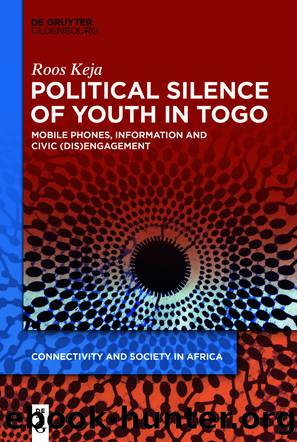Political Silence of Youth in Togo by Roos Keja

Author:Roos Keja
Language: eng
Format: epub
Publisher: De Gruyter
Published: 2022-02-21T11:52:29.712000+00:00
4.6
What phones reflect: Desires, realities, identities
Displaying identities: Colours WhatsApp status and eating chicken
The things a person owns say a lot about them. This is especially the case when it concerns things that people take along with them into public spaces, such as clothes, shoes, bags, vehicles and phones. Hassan and Unwin (2017: 87) note that the cultural impact of mobile phone use on identity construction in âpoorer countriesâ as a focus of research has remained somewhat understudied, other than an edited volume they mention by Buskens and Webb (2014) for the African continent.
The brand, type and colour of the phone are the first to be visible. Depending on the type of phone, if one gets close one can see the wallpaper, and inside the phone the images, messages, contact list, applications and status updates: the image of a personâs life. Phones are among peopleâs most private objects, yet they are visible in public.
Carrying a snazzy or expensive phone can be one way to show that a person is in control and successful, and draw both admiration and jealousy as result. People who carry an original Samsung or Sony Ericsson will receive compliments and admiration, because the quality of these brands is believed to be high. Nonetheless, a new top brand is not within reach for most people, who emphasise that they just want a phone that works, no matter the colour and type. They are not in the financial position to choose the best phone, and when choosing between quality and oneâs favourite colour, quality prevails. Some people base their choice of a phone on the experience of others, but choices are mostly motivated by a limited budget. Whenever a batch of a certain colour of phones is sold with a promotion, for instance a pink phone in 2016, several adolescents are seen with this phone.
Wallpapers, profile photos and status updates are another area in which mobile phones play a role in identity construction. Partners and children often show up on peopleâs wallpapers that I have seen, and I also took great interest in the images and written statuses of peopleâs Whatsapp accounts. For instance, Mohamedâs welcome screen of his phone often displays his car, since he is a driver and earns his money with his car. He often changes the image of his Whatsapp status, showing his car with or without him, or his wife and children. By contrast, the welcome screen of the phone of another driver called Pili-Pili (because he is âas hot as pepperâ) displays a woman in bikini on the beach (observations, 26 February 2015).
The way in which people present themselves, supported by their images on their phones, says a lot about their social position. Another example comes from Didi, a girl who lived close to the house in Komah where I stayed in 2015 and 2016. I met her on the street in June 2016 and she invited me in, and I met her again some weeks later with schoolteacher Johnny who was part of the research team and who obviously knew her.
Download
This site does not store any files on its server. We only index and link to content provided by other sites. Please contact the content providers to delete copyright contents if any and email us, we'll remove relevant links or contents immediately.
| Africa | Americas |
| Arctic & Antarctica | Asia |
| Australia & Oceania | Europe |
| Middle East | Russia |
| United States | World |
| Ancient Civilizations | Military |
| Historical Study & Educational Resources |
Goodbye Paradise(2974)
Men at Arms by Terry Pratchett(2408)
Tobruk by Peter Fitzsimons(2065)
Pirate Alley by Terry McKnight(1911)
Arabs by Eugene Rogan(1841)
Borders by unknow(1791)
Belonging by Unknown(1473)
The Biafra Story by Frederick Forsyth(1327)
It's Our Turn to Eat by Michela Wrong(1305)
Botswana--Culture Smart! by Michael Main(1239)
A Winter in Arabia by Freya Stark(1226)
Gandhi by Ramachandra Guha(1198)
Coffee: From Bean to Barista by Robert W. Thurston(1184)
Livingstone by Tim Jeal(1154)
The Falls by Unknown(1143)
The Source by James A. Michener(1137)
The Shield and The Sword by Ernle Bradford(1102)
Egyptian Mythology A Fascinating Guide to Understanding the Gods, Goddesses, Monsters, and Mortals (Greek Mythology - Norse Mythology - Egyptian Mythology) by Matt Clayton(1089)
Africa: Altered States, Ordinary Miracles by Richard Dowden(1080)
